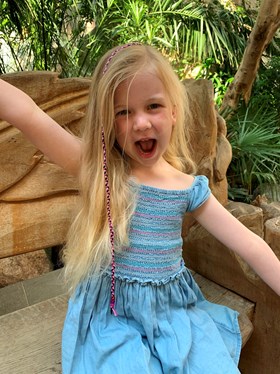Our family's experience of Auditory Verbal therapy
Published Date: 01 Jul 2021
When our daughter Sybil received her first cochlear implant at 18 months old, we thought the hard part was over – the surgery was done and we could relax. Little did we know that our work was yet to begin. Teaching a deaf child who has never heard any sound to make use of their amazing new tool is a mammoth task. Our implant centre, though, offered Auditory Verbal therapy (AVT) to guide us through this tricky transition.
I knew little about AVT. Most of what I knew came from the internet, and, as is pretty common online, opinions were split… I was concerned when I read that AVT discouraged sign, as Sybil was doing well with British Sign Language (BSL) and our communication was good. However, we wanted to give her the best chance of understanding spoken English and AVT was said to be a great way for deaf children to learn to listen and catch up with their hearing peers quickly.
AVT relies on a child having good access to sound, so optimally fitted cochlear implants or hearing aids, worn regularly, are needed. The AVT sessions themselves were very structured, with Sybil, the therapist, and me or my husband Adam focussing on an activity – but they were far from boring! In some sessions we’d do a jigsaw or look at a book. In others, we’d set up a shop, craft, or blow up then release balloons, watching them whizz around the room. We’d have races with wind-up toys, play with Play Doh, splash around with water, or go into the corridor and throw balls at skittles. Every session was different and so much fun for Sybil, who was always excited to head to AVT. She never realised she was being ‘therapised’. As far as she was concerned she was getting an hour of interesting and exciting playtime! We learnt things in the sessions that we could incorporate into home life, and I don’t think it’s an exaggeration to say that AVT techniques have shaped how we communicate with both of our children.
When Sybil’s cochlear implants were first activated we’d walk around our neighbourhood looking for cars, dogs or aeroplanes, using the ‘learning to listen’ sounds to identify them. I’d talk all day long, narrating everything, which I must admit was absolutely exhausting, and one of the harder things for me. In every game we played we would be thinking about how we could extend the language. We’d work on building her auditory memory, with the aim that she could hold spoken instructions in her head and recall them in the right order, and we’d work on theory of mind, the ability to recognise that people all have different thoughts and feelings. Both of these skills can be hard for deaf children to grasp.
We were never discouraged from signing by the implant centre, but as Sybil’s spoken language came along, we signed at home less. This was partly because our BSL skills were too basic for her ever-growing understanding – learning a new language while simultaneously teaching it to your child is an immense challenge. Also, sadly, our local deaf family centre closed down due to lack of funds and Sybil was exposed to BSL less and less. Now we use some basic sign to help out in noisy situations, or when Sybil has her processors off. If, in the future, her needs or circumstances change, we’ll be happy to reintroduce her to BSL, and we’ve carried on with our BSL classes even though we don’t use it at home.
